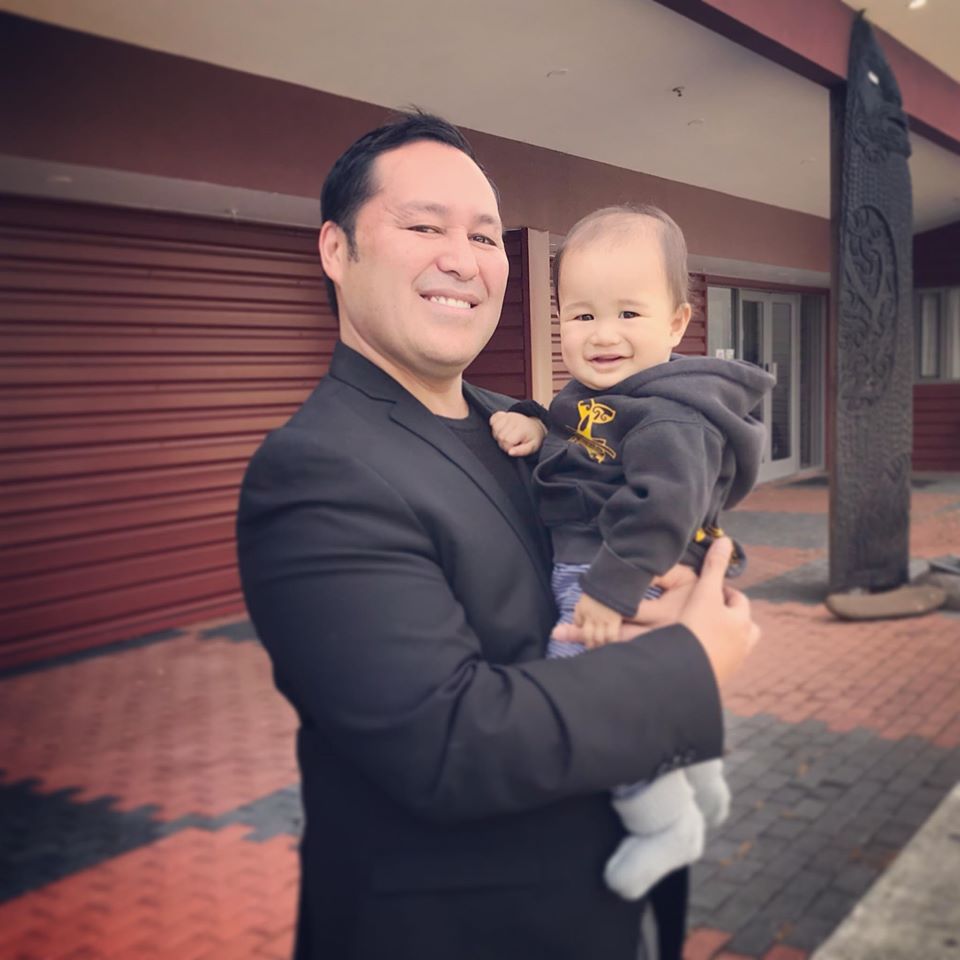Published online: June 2020
Synthesis by: Dr Valance Smith, AUT (valance.smith @ aut.ac.nz); Peter Edwards (AUT), Dr John Perrott (AUT), Assoc.Prof. Hannah Buckley (AUT), Dr David Norton (University of Canterbury), Dr Leilani Walker (AUT)
Valance Smith and son Āio Te Irirangi at Te Māhurehure marae, Auckland: reflecting the importance of future-proofing the next generation.
The Situation
There is increasing recognition worldwide that native biodiversity plays a vital role in building agricultural ecosystem resilience. Kaitiakitanga is a key principle from the Māori world view to assist in sustaining native biodiversity in New Zealand landscapes. However, we argue that in agricultural landscapes, kaitiakitanga alone cannot achieve desired biodiversity outcomes. Like kaitiakitanga, agroecology is a holistic pathway for incorporating ecological and social processes into the management of agricultural landscapes using methods that will protect the land, biodiversity and consequently the people. In addition to kaitiakitanga aspirations of sustaining land and resources, our primary question is what is the innovation within mātauranga Māori (Māori knowledge) that might also lead to enhanced yields and increased profits for all?
The Challenge
Mātauranga Māori is a complex and open system of knowing the world. The challenge is identifying innovations within this open and complex system pertinent to building agricultural ecosystem resilience in Aotearoa. At the heart of this conversation is building resilience by incorporating mātauranga Māori into Western approaches to agroecology.
Kaitiakitanga as a land ethic has multiple but distinct layers of meaning and several pathways to navigate the human-nature continuum. One such layer is the relationship between mana (respect and authority) and whenua (land and placenta). Māori values and principles form the ethical framework where Māori can legitimately engage with the land, as they provide the ‘instruments through which Māori make sense of, experience, and interpret their environment’. One of these values is respect for mana whenua (authority over land and resources derived from a physical and spiritual connection to the land).
The Opportunity
The ‘economy of mana’ as a land ethic framework highlights the notion of enhancing and protecting the mana within people and their communities. It is associated with manaakitanga (hospitality), utu (reciprocity, exchange), aroha (compassion), whanaungatanga (relationships) that all relied, and still rely, on the nurturing and utility of natural resources. Thus, it stems from a Māori worldview, using traditional mātauranga principles, informed by traditional Māori economics which is firmly grounded by utu (reciprocity) or as some have coined it, ‘the economy of affection’. Furthermore, the economy of mana focuses on four well-beings -spiritual, ecological, kinship, and economic. Resource development and harvesting are fixed in the ecological system that sustains them. Therefore, an essential component that regulates these four well-beings for resource development and harvest is rāhui (restricted access).
Kaitiakitanga is similarly about caring and nurturing, whether it is nature or whānau, or whānau whānui (wider family). Both approaches are imbued with wairuatanga asserting spiritual intimacy with the land. However, the opportunity is that the economy of mana extends to resource development and harvesting. This framework emphasises the potential to manage natural resources such that those resources can be successfully harvested and restored without long- or short-term detriment to the resource itself. This echoes the sentiments of agroecology, which focuses on how the sustainability of land and resources is driven by human behaviour. In light of this, the economy of mana encourages us to reimagine and rethink our approach to the sustainability and enhancement of native biodiversity in agroecosystems. To achieve this we need to consider clearly defined decision-making and co- management processes that combine private and mana whenua (kaitiaki) rights that ensure the protection of mana whenua knowledge. How we might do that is to look at and work in partnership with current marae- and hapu-based initiatives that practice Māori- centric approaches in the management of their agroecosystems. The transformative potential of the economy of mana is worth further investigation as it offers an alternative approach to agroecology that protects the land, biodiversity and the people.
References
Altieri, M.A. 1989. Agroecology: A new research and development paradigm for world agriculture. Agriculture, Ecosystems & Environment, 27: 37-46
Altieri, M.A. 2018. Agroecology: the science of sustainable agriculture. CRC Press.
Harmsworth, G.R, Awatere, S. 2013. Indigenous Māori knowledge and perspectives of ecosystems. In: Dymond JR ed. Ecosystem services in New Zealand: conditions and trends. Lincoln, New Zealand, Manaaki Whenua Press. Pp. 274-286.
Dell, K., Staniland, N., Nicholson, A. 2018. Economy of Mana: Where to next? MAI Journal: A New Zealand Journal of Indigenous Scholarship. 7: 10.20507/MAIJournal.2018.7.1.5
Koohafkan, P., Altieri, M. A., Gimenez, E. H. 2012. Green agriculture: foundations for biodiverse, resilient and productive agricultural systems. International Journal of Agricultural Sustainability, 10: 61-75
Maxwell, K. H., Penetito, W. 2007. How the use of rāhui for protecting taonga has evolved over time. Mai Review 2
Spiller, C., Pio, E., Erakovic, L., Henare, M. 2011. Wise up: Creating organizational wisdom through an ethic of Kaitiakitanga. Journal of Business Ethics, 104: 223-235
Stein, K., Mirosa, M., Carter, L. 2018. Māori women leading local sustainable food systems. AlterNative: An International Journal of Indigenous Peoples, 14:147-155
Taiepa, T., Lyver, P., Horsley, P., Davis, J., Brag, M., Moller, H. 1997. Co-management of New Zealand's conservation estate by Māori and Pākehā: a review. Environmental conservation, 24: 236-250

